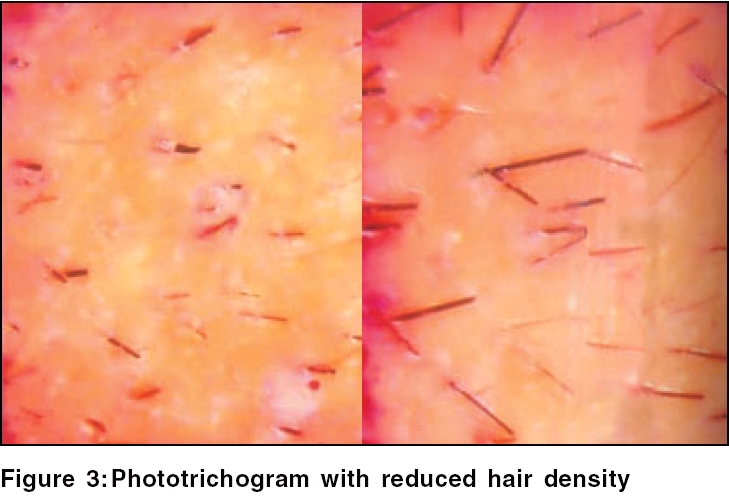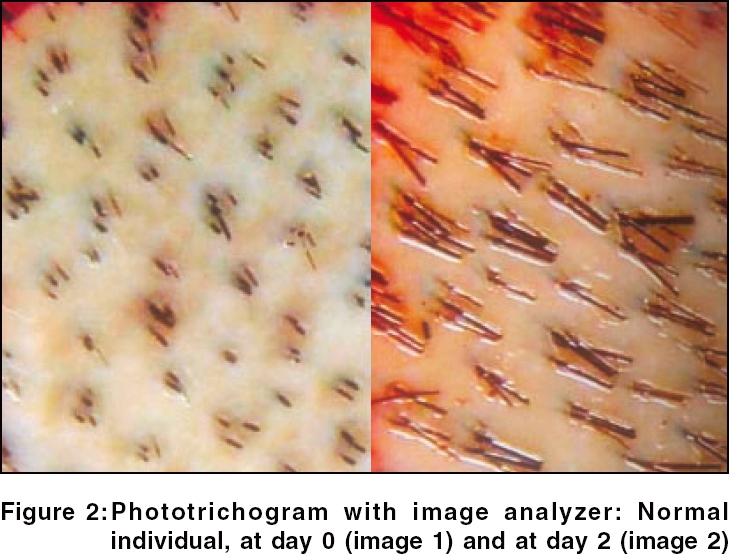Translate this page into:
Phototrichogram
Correspondence Address:
Rachita Dhurat
Department of Dermatology, LTMM College and LTMG Hospital, Sion, Mumbai
India
| How to cite this article: Dhurat R. Phototrichogram. Indian J Dermatol Venereol Leprol 2006;72:242-244 |
 |
 |
 |
 |
 |
 |
 |
 |
Established cases of androgenetic alopecia (AGA) are easy to recognize in men. However, AGA is harder to discern in women, with an intact frontal hairline and diffuse milder thinning over the vertex. The most common forms of hair loss like androgenetic alopecia (AGA) and telogen effluvium (TE) require quantification to assess the degree of hair loss and response to treatment.
Numerous methods have been reported to assess hair variables,[1] viz,. density, growth rate, anagen/telogen ratio and hair diameter. These techniques can be classified as either invasive (e.g., biopsies[2],[3]), semi-invasive (trichogram,[4],[5] unit area trichogram[6]) or noninvasive (e.g., global hair count,[7] phototrichogram[8],[9],[10],[11],[12],[13]) methods.
Trichogram
The standard trichogram is a method for quantifying hair loss or monitoring the effect of therapy. It can be used to quantify and characterize effluvium (anagen/telogen). The classic trichogram involves several, usually painful, epilations. In the case of androgenetic alopecia (AGA), epilation is done on a balding scalp area and as a comparative control, on a scalp area not affected by the condition, i.e., on the occiput. Microscopic counting of the hair roots enables calculation of the anagen/telogen ratio and hence, one can determine the severity of hair loss. More than 50 hairs need to be epilated for the trichogram results to be reliable or valid.
In addition to the pain of epilation, the need to abstain from washing hair for several days before the procedure, limits the significance of the trichogram. Besides, it requires experience to obtain a sample of undamaged hairs and this affects the results of the test. Standardization of conditions for the epilations is crucial for reproducibility of results. The examiner has to be aware that the site of epilation and the amount of epilated hair can vary from session to session, which leads to variability of test results and affects the diagnostic accuracy of the procedure. Thus the standard trichogram has a role in the basic evaluation of hair loss, but when compared to phototrichogram, it has several disadvantages.
Phototrichography
First introduced by Saitoh in 1970,[8] the phototrichogram (photographic trichogram) is a noninvasive technique that is simpler and more reproducible and sensitive than a trichogram. It allows the in vivo study of the hair growth cycle. It can be used to find the rate of hair growth, size of hair fibers and frequency of telogen hair follicles and to quantify shed hair. Several variants of the phototrichogram have become popular for evaluating hair in the clinic and in clinical research trials.
Saitoh et al .[8] developed a method for measuring the ratio of anagen, catagen and telogen to the full cycle of growth in human scalp. All hairs in a 2 sq cm area are trimmed 1 mm from the skin surface [Figure - 1] and a baseline photograph is taken. After a week, the same region is photographed and the hairs are trimmed again. This process is repeated until enough pictures are available for comparison. By comparing with the baseline picture, one can observe as to which hair fibers have grown (follicles in anagen) and which have not (follicles in telogen) [Figure - 2], the rate of hair growth (the length of hair in 7 days), the density of the hair (the number of hairs in the photograph) and which hair fibers are missing 5 days later (an indication of the rate of hair shedding) [Figure - 3][Figure - 4].
To facilitate observation over a long period of time, a dot is tattooed on the volunteer′s scalp. The tattoo allows another phototrichogram at the same spot several months later. This is useful for testing new hair loss treatments and quantitatively evaluating hair growth in the same spot over the long term.
Digital phototrichogram
At the beginning, phototrichogram analysis was done manually; the photographs on day 0 and day 5 would be placed side by side for comparison. The length and diameter of hair fibers would be measured with a ruler and then the average hair growth rate calculated. This technique has been improved by image analysis and later, by the use of immersion oil (scalp immersion proxigraphy photographic method)[9] and digital contrast enhancement.[10] The scalp immersion proxigraphy photographic method involves using close-up photography, where the scalp is viewed under a glass slide with a drop of immersion oil. This increases the resolution of the image and gives more clarity to the image under similar magnification conditions. The remaining procedure is similar to that in a classical phototrichogram. The contrast-enhanced phototrichogram procedure involves coloring hair with black-colored dye immediately before the procedure. These temporarily colored hairs give a better contrast against the white scalp, making this method more sensitive for less pigmented and thin hairs.
However, all these methods are tedious and very time consuming; consequently, a phototrichogram is not commonly used in the general dermatology clinic. Hence, need for development of a computerized automated phototrichogram system that could be easily used in a dermatology clinic has been felt since many years.
Hoffmann, in 2001, developed a commercial fully computerized phototrichogram technique with automated software named ′Trichoscan′.[14] A target area (a transitional area of hair loss between normal hair and the balding area in male AGA and mid-vertex in women with diffuse hair loss) of 1.8 cm 2 is chosen for clipping. The area on the scalp is marked with a central black tattoo. The clipped hairs within the target area are dyed for gray or fair hairs and photographs are taken immediately after shaving, 2 or 3 days after shaving with a digital close-up camera with epiluminescence microscopy. These two photographs are then examined by a software system that is able to recognize individual hair fibers in the photographs. By comparing the two photographs, the computer can determine which hairs are growing and which are not. Trichoscan can be used to monitor the success of treatment, as it is reproducible.
The Trichoscan system is now available on the Internet (http://www.trichoscan.com). The primary advantage of this technique is that it can be used for clinical studies to compare placebo versus treatment or to compare the efficacy of various hair growth promoting substances. Phototrichogram can be used for studying AGA or other forms of diffuse hair loss and it can be adopted to study the effect of drugs or laser treatment on hypertrichosis or hirsutism.[14]
| 1. |
Barth JH, Rushton DH. Measurment of hair growth. In: Serud J, Jemec GB, editors. Non-invasive method and the skin. Ann Arbor: CRP Press; 1995. p. 543-8.
[Google Scholar]
|
| 2. |
Headington JT. Transverse microscopic anatomy of the human scalp: A basis for morphometric approach to disorders of the hair follicle. Arch Dermatol 1984;120:449-56.
[Google Scholar]
|
| 3. |
Whiting DA, Waldstreicher J, Sanchen M, Kaufman KD. Measuring reversal of hair miniaturization in androgenetic alopecia by follicular counts in horizontal sections of serial scalp biopsies: results of finasteride 1 mg treatment of men and postmenopausal women. J Invest Dermatol Symp Proc 1999;43:282-4.
[Google Scholar]
|
| 4. |
Maguire HC Jr, Kligman AM. Hair plucking as a diagnostic tool. J Invest 1964;43:77-9.
[Google Scholar]
|
| 5. |
Blume-Peytavi U, Orfanos CE. Microscopy of the hair. In : Serud J, Jemec GB, editors. Non-invasive method and the skin. CRP Press: Ann Arbor; 1995. p. 549-54.
[Google Scholar]
|
| 6. |
Rushton H, James KC, Mortimer CH. The unit area trichogram in the assessment of androgen - dependent alopecia. Br J Dermatol 1983;109:429-37.
[Google Scholar]
|
| 7. |
Canfield D. Photographic documentation of hair growth in androgenetic alopecia. Dermatol Clin 1996;14:713-21.
[Google Scholar]
|
| 8. |
Saitoh M, Uzuka M, Sakamoto M. Human hair cycle. J Invest Dermatol 1970;54:65-81.
[Google Scholar]
|
| 9. |
Van Neste DJ, Dumrotier M, de Brouwer B, de Coster W. Scalp immersion proxigraphy: An improved imaging technique for phototrichogram analysis. J Eur Acad Derm Venereol 1992;1:187-91.
[Google Scholar]
|
| 10. |
Van Neste DJ. Contrast enhanced phototrichogram (CE-PTG): An improved non-invasive technique for measurement of scalp hair dynamics in androgenetic alopecia - validation study with histology after transverse sectioning of scalp biopsies. Eur J Dermatol 2001;11:326-31.
[Google Scholar]
|
| 11. |
Rushton DH, de Brouwer B, de Coster W, van Neste DJ. Comparative evaluation of scalp hair by phototrichogram and unit area trichogram analysis within the same subjects. Acta Derm Venereol 1993;3:150-3.
[Google Scholar]
|
| 12. |
Hayashi S, Miyamoto I, Takeda K. Measurement of human hair growth by optical microscopy and image analysis. Br J Dermatol 1991;125:123-9.
[Google Scholar]
|
| 13. |
D'Amico D, Vaccaro M, Guarneri F, Borgia F, Cannavo S, Guarneri B. Phototrichogram using videomicroscopy: A useful technique in the evaluation of scalp hair. Eur J Dermatol 2001;11:17-20.
[Google Scholar]
|
| 14. |
Hoffmann R. TrichoScan: Combining epiluminescence microscopy with digital image analysis for the measurement of hair growth in vivo. Eur J Dermatol 2001;11:362-8.
[Google Scholar]
|
Fulltext Views
10,118
PDF downloads
2,896





